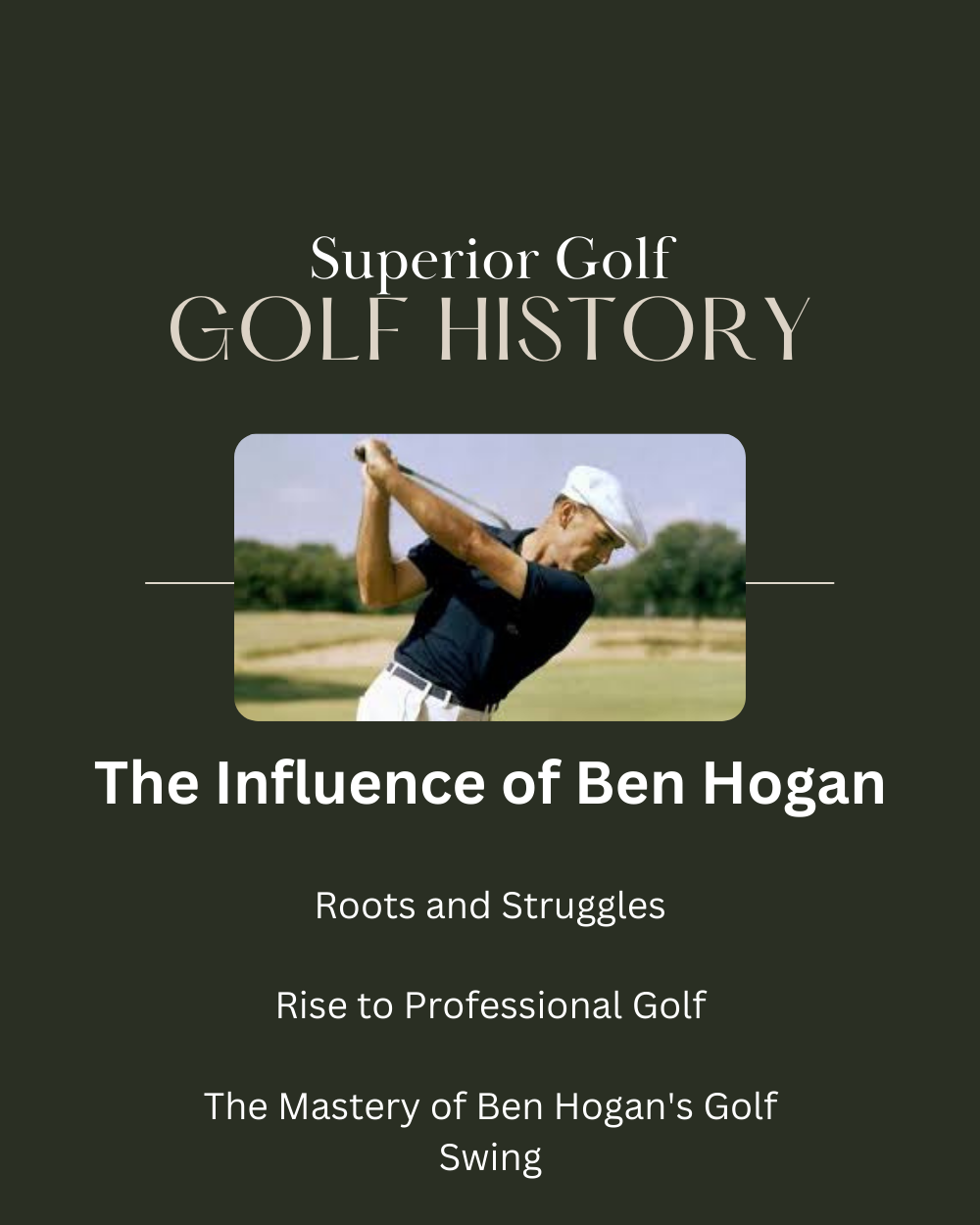Ben Hogan was born on August 12, 1912, in Dublin, Texas. He became one of golf’s greatest players. His journey showed great resilience, conquering many personal and professional challenges.
Hogan’s impressive career includes 64 PGA Tour wins, making him one of the best ever. He won nine major championships, like Gary Player12. Hogan was one of the few to win all four major championships: the Masters, The Open Championship, the U.S. Open, and the PGA Championship12. He first won a major at 34 and shone in 1953, winning three majors, known as the Triple Crown of Golf12.
Hogan impacted golf with his innovative swing and practice routines. He served in the U.S. Army Air Forces from 1943 to 1945. Despite a severe car accident in 1949, he made a legendary comeback1.
Moreover, Hogan founded The Ben Hogan Company in 1953, advancing golf technology2. His legacy includes various awards, highlighting his lasting impact on the sport.
When Hogan died on July 25, 1997, a famous golf commentator said, “We’ve lost our unicorn.”2 This shows the high regard people had for Hogan.
Key Takeaways
- Ben Hogan won 64 PGA Tour tournaments and nine major championships, ranking him among golf’s greats12.
- He was one of five players to win golf’s Grand Slam, securing all four major championships12.
- His unforgettable 1953 season with three major wins is known as the Triple Crown of Golf12.
- Hogan revolutionized golf swing theory, influencing how the game is played today1.
- His founding of The Ben Hogan Company marked a leap forward in golf equipment technology2.
Early Life and Career Beginnings
Ben Hogan was born in Stephenville, Texas, into a blacksmith’s family. Tragedy struck when his father took his own life, leaving young Ben at just 9 years old3. Yet, Hogan found escape and direction in golf, starting as a caddy. He made only 65 cents a game3. These early experiences built the base of his future in golf.
Roots and Struggles
Hogan was the youngest child in a family that faced much hardship. The loss of his father pushed him to be resilient. It changed him, making him strive for greatness despite tough times. While caddying, he showed incredible spirit, seeing beyond his day-to-day struggles.
Hogan’s drive never wavered, even when success seemed far. It took him 10 years to perfect his golf swing3. His wife Valerie was his rock during these hard times, believing in him even when wins were rare1.
Rise to Professional Golf
Hogan turned pro before he turned 18, at the Texas Open in January 19301. His start on the PGA Tour was tough, with more losses than wins. But Hogan never gave up. He kept refining his swing, aiming for perfection.
World War II and a severe car crash at 36 could have ended his career1. These events only made his comeback stronger. By November 1949, he was playing golf again1, showing his incredible resolve.
In 1953, Hogan dominated the golf world, winning five out of six tournaments. This included three majors1. His rise from a difficult childhood to a golf legend is inspirational. It shows the power of never giving up.
The Mastery of Ben Hogan’s Golf Swing
Ben Hogan’s swing was known for its accuracy and unique mechanics. His technique made his swing consistent, avoiding a common mistake of flattening during the downswing4. His training, especially his focus on specific clubs for certain distances, was innovative. It showed his deep dedication to mastering his golf swing.
At the Milo Lines Golf Academy in Phoenix, Arizona, golfers learn one-arm drills. These drills improve the positioning of the right arm, a technique Hogan valued5. By positioning the right arm correctly, golfers can mimic Hogan’s powerful lower body movement in their swings54.
Hogan had a special way of holding his golf club at the start. He aligned the club’s shaft with his belt and the center of his body4. He stood with his hips open, ready to strike the ball well. This stance helped him make his special low cut shots with great control5.
Hogan’s mastery was also clear in how he moved his club. His club moved in a line that matched his starting stance all the way through his swing4. When he hit the ball, his right elbow was behind his hip with his heel up, showing his powerful lower body action4.
After hitting the ball, Hogan slightly stood up. This move helped him control the club’s release and avoid mistakes4. His attention to detail and commitment made his swing a model for precision and control in golf.
Career Achievements and Major Wins
Ben Hogan’s career achievements show he’s a legend in golf. He won 64 PGA Tour titles, ranking him fourth in history1. His nine major championship wins tie him for fourth with Gary Player12. Hogan is celebrated for winning all four major golf championships: the Masters, The Open, the U.S. Open, and the PGA Championship12.
The Comeback: Overcoming Adversity
Ben Hogan’s comeback is a legendary sports story. In 1949, he had a serious car accident, breaking his pelvis and collarbone1. Despite serious injuries, Hogan made an incredible return. He won the U.S. Open in 1950, showing amazing strength1. Hogan’s recovery shows his strong character and love for golf.
1953: The Year of the Triple Crown
1953 was a big year for Hogan. He won five out of six tournaments, including three majors12. This “Triple Crown of Golf” highlighted his dominance and legacy. Hogan’s performance in 1953 is still celebrated, emphasizing his skill and determination.
Hogan changed golf swing theory with his hard work and new techniques. His practice methods and major wins inspire golfers everywhere. Hogan’s story teaches us that champions are made with resilience and dedication.
Conclusion
Ben Hogan made a huge impact in golf history, thanks to his outstanding achievements. He won 71 pro golf tournaments, including nine majors1. Hogan is one of five players to win all four major championships: Masters, Open, U.S. Open, and PGA Championship1. He won his first major at 341, showing his never-give-up attitude and late success.
In 1953, Hogan had an amazing Triple Crown season1. He won five of the six tournaments he played, with three being majors1. This incredible achievement solidified his status in golf. It also showcased his lasting role as one of golf’s best. Despite challenges, like not liking the PGA Championship format and overcoming injuries from a car crash in 1949, Hogan stayed dedicated to golf1.
Hogan’s impact goes beyond his awards. He was a pioneer in matching clubs to distances for better control. He also adopted a “strong” grip to compete with stronger players1. His methods and stellar career keep inspiring golfers everywhere, making his name a symbol of excellence1.
To really understand Hogan’s effect on golf, check out his bio on Wikipedia. You can also see how he’d fit into today’s game at Golf.com. His story is one of resilience and unmatched skill, leaving a deep impact on golf. It’s a legacy that continues to touch the hearts of fans and players alike.
FAQ
What is Ben Hogan’s influence on golf?
What were the key moments early in Ben Hogan’s life and career?
How did Ben Hogan develop his legendary golf swing?
What were Ben Hogan’s major career achievements and wins?
How did Ben Hogan overcome his near-fatal car accident?
What is the significance of Ben Hogan’s 1953 season?
How does Ben Hogan’s legacy continue to influence golf today?
Source Links
- https://en.wikipedia.org/wiki/Ben_Hogan
- https://www.texasgolfhof.org/exhibit/ben-hogan
- https://www.benhoganmuseum.org/the-hogan-story
- https://rotaryswing.com/golf-instruction/ben-hogan/ben-hogan-swing-analysis-down-the-line
- https://www.rukket.com/blogs/golf/mastering-the-iconic-ben-hogan-swing-simple-golf-tips-from-milo-lines-golf-academy

